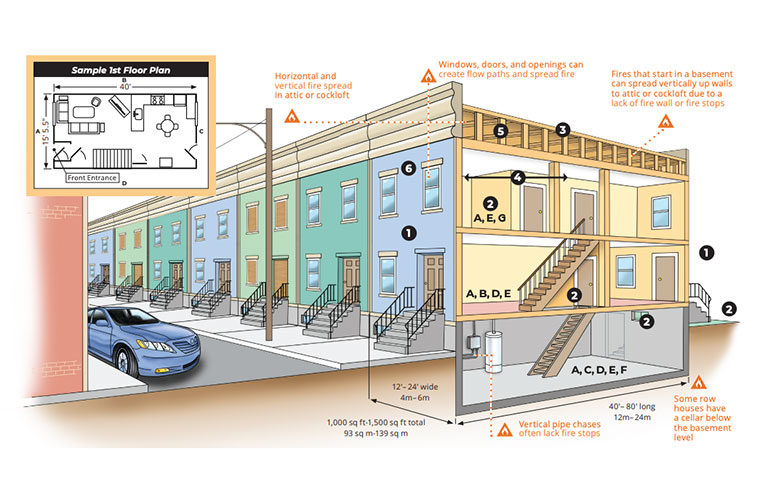Row house fires: New safety resources for firefighters

Washington — A new poster and fact sheet from NIOSH are designed to help educate firefighters about the unique nature of row house fires and how to stay safe when fighting these blazes.
Row houses are dwellings connected by shared sidewalls that form a single building. The resources outline typical features of exterior and interior row houses, tactics for fighting fires in these locations, and common areas where fires may spread. Fires that start in the basement of a row house potentially can spread vertically up walls, NIOSH says, extending to an attic or loft as a result of a lack of a fire wall or fire stops. Windows, doors and openings can create airflow paths that help spread the fire.
NIOSH recommends firefighters conduct a community risk assessment to understand row houses in their jurisdiction, noting that architectural modernization efforts “may mean the exterior is refaced and interior has a different floor plan.” Additionally, materials used for row house modernization or construction may burn more rapidly.
As part of the resources, Philadelphia Fire Department Assistant Chief Harry Bannan urges firefighters never to underestimate the danger of row house fires.
“Access to the rear of the property is a major challenge,” Bannan says. “Basement and cellar fires in row houses have resulted in many line-of-duty deaths. You must be diligent and prepare as though you’re going to a fire each time you report for duty.”
In a press release, NIOSH Director John Howard noted the efforts of the agency’s Fire Fighter Fatality Investigation and Prevention Program in investigating firefighter deaths associated with row house fires.
| Sign up for Safety+Health's free monthly email newsletters and get the news that's important to you. |
“It is our hope that the valuable information conveyed by these new materials prevents another tragedy by helping every firefighter who responds to a row house fire return home unharmed,” Howard said.
The agency suggests firefighting organizations display the poster in common areas of fire stations and use the fact sheet as a training resource.
The materials were developed in conjunction with fire service organizations including the U.S. Fire Administration, International Association of Fire Chiefs and International Association of Fire Fighters.
Post a comment to this article
Safety+Health welcomes comments that promote respectful dialogue. Please stay on topic. Comments that contain personal attacks, profanity or abusive language – or those aggressively promoting products or services – will be removed. We reserve the right to determine which comments violate our comment policy. (Anonymous comments are welcome; merely skip the “name” field in the comment box. An email address is required but will not be included with your comment.)

